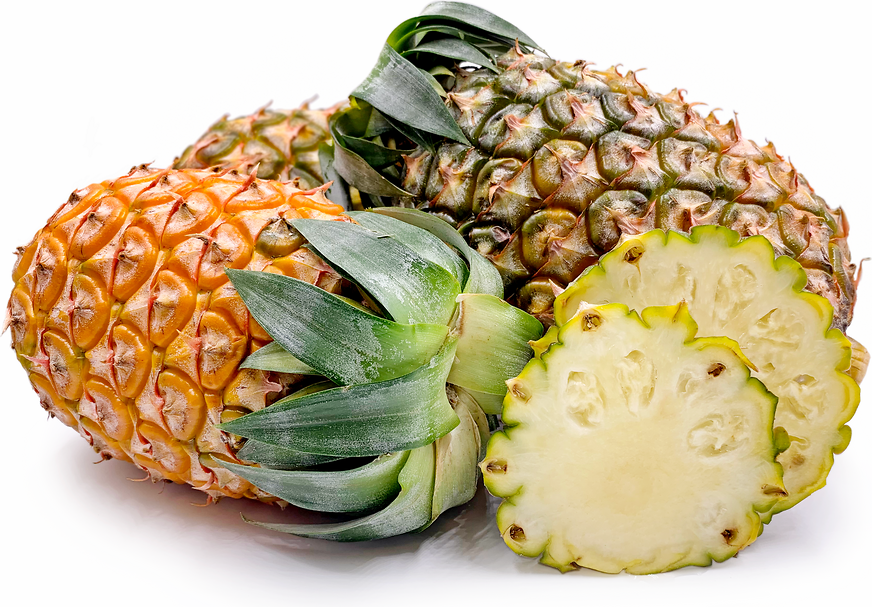


Chura Pineapples
Estimated Inventory, lb : 0
Description/Taste
Chura pineapples are small in size, averaging ten centimeters in diameter, and are cylindrical to oval in shape with short, dark green leaves forming a spikey crown. The rind matures from green to orange-yellow when ripe and is waxy and semi-rough with a hexagonal pattern of spiny nodes. Underneath the rind, the bright yellow flesh is soft, fragrant, moderately juicy, and tender, containing less fiber than common pineapple varieties. The flesh also contains a unique central core that is crisp, soft, and edible. Chura pineapples have a high sugar content mixed with low acidity creating a sweet, candy-like flavor.
Seasons/Availability
Chura pineapples are available for a limited season in the summer.
Current Facts
Chura pineapples, botanically classified as Ananas comosus, are categorized as a collective fruit, which means it is comprised of multiple nodes or “berries” fused to a central core. Considered to be a small, specialty pineapple, Chura is a brand name used in Japan to market the snack pineapple, which is a variety valued for its tender, pull apart flesh. Chura pineapples are cultivated in Okinawa, Japan, and the small fruits have a unique structure that allows the individual nodes to be removed into bite-sized pieces. Chura pineapples are consumed primarily for fresh eating and are favored for their very sweet flavor.
Nutritional Value
Chura pineapples are a good source of vitamin C, which is an antioxidant that can help boost immunity within the body and protect against free radical damage. They also contain vitamin B6, manganese, fiber, potassium, folate, copper, and bromelain, which is an enzyme that can help increase digestion.
Applications
Chura pineapples are best suited for raw applications as their sweet flavor is showcased when consumed fresh, out-of-hand. The bottom of the pineapple is commonly sliced, removed, and each small hexagonal node is torn from the core to create bite-sized pieces. Chura pineapples can also be sliced and tossed into green salads and fruit bowls, blended into smoothies, or used as a topping over cakes, ice cream, and other desserts. Chura pineapples pair well with fruits such as oranges, mangoes, pears, grapefruit, apples, passion fruit, bananas, and peaches, black garlic, tomatoes, soy sauce, peanuts, and meats such as poultry and fish. The pineapples should be used immediately when ripe for best flavor and can be lightly wrapped and stored in the crisper drawer of the refrigerator for up to one week.
Ethnic/Cultural Info
In the Okinawa Prefecture of Japan, the Nago Pineapple Park is an attraction created to educate visitors about pineapples. At the park, visitors can learn the history behind how pineapples were spread across the world, ride through pineapple fields in a pineapple themed tram, visit tropical gardens, and take pictures beside a large pineapple monument. The Nago Pineapple Park also contains over two hundred varieties of pineapples including the snack pineapple, and there are pineapple themed desserts where visitors can sample different varieties in popsicles, cream puffs, parfaits, and ice cream. There is even a pineapple-themed gift shop that sells pineapple candies and pineapple wine.
Geography/History
Chura pineapples are native to the Okinawa Prefecture in Japan where they have been cultivated since the 1920s. While the exact origins of the Chura pineapple are unknown, they are believed to be a brand name of the snack pineapple, which is a variant of the bogor pineapple, and are mainly cultivated on Okinawa Island, Ishigaki Island, Miyako Island, and Iriomote island within the Okinawa Prefecture in Japan. Today Chura pineapples are found at specialty grocers and farmers markets in Japan and are exported to the Philippines. The pineapples can also be found at specialty stores in select regions throughout Asia and Southeast Asia.








